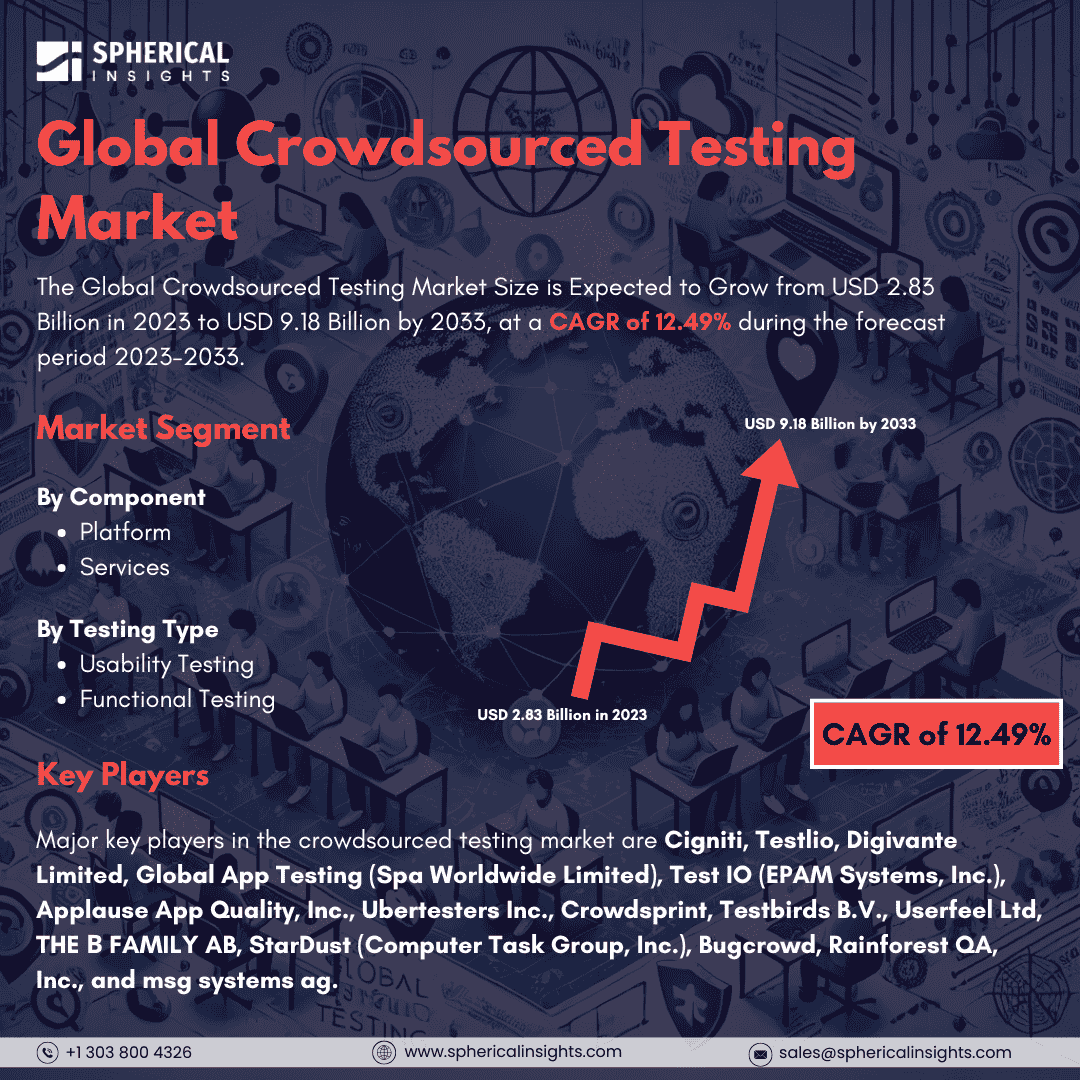Global Crowdsourced Testing Market Size to worth USD 9.18 Billion by 2033
According to a research report published by Spherical Insights & Consulting, The Global Crowdsourced Testing Market Size is Expected to Grow from USD 2.83 Billion in 2023 to USD 9.18 Billion by 2033, at a CAGR of 12.49% during the forecast period 2023-2033.
Browse key industry insights spread across 210 pages with 110 Market data tables and figures & charts from the report on the Global Crowdsourced Testing Market Size, Share, and COVID-19 Impact Analysis, By Component (Platform and Services), By Testing Type (Usability Testing and Functional Testing), and By Region (North America, Europe, Asia-Pacific, Latin America, Middle East, and Africa), Analysis and Forecast 2023 – 2033.
Millimeter wave sensors and modules are advanced, next-generation products that run based on the millimeter wave range, commonly between 30 GHz to 300 GHz. Their main usage would be high-precision purposes such as imaging, sensing, radar, and communication systems. Due to the nature of millimeter waves, such devices permit real-time, accurate detection, ranging, and sensing with extremely high resolution for applications including automobile, aerospace, telecoms, health care, and security services. Furthermore, several factors are driving the growth of the millimeter wave sensors and modules market. These include the increasing demand for advanced driver assistance systems (ADAS) in the automotive sector, especially for collision avoidance and autonomous driving applications. The increasing adoption of millimeter wave technology in 5G communication networks to enhance data transmission speeds and reduce latency is further fueling market expansion. The need for high-resolution imaging and sensing in medical and industrial applications supports the growth of the market. However, there are some restraining factors to this market. The cost of production and manufacturing complexity in millimeter wave sensors and modules can restrain their use in large areas.
The platforms segment is predicted to hold the greatest market share through the forecast period.
Based on the component, the crowdsourced testing market is classified into platforms and services. Among these, the platforms segment is predicted to hold the greatest market share through the forecast period. This is primarily due to the increasing reliance on automated platforms that provide efficient, scalable, and accessible testing solutions. These platforms enable businesses to easily manage crowdsourced testing, by connecting them with a global pool of testers and facilitating the management of testing projects.
The functional testing segment is anticipated to hold the greatest market share during the projected timeframe.
Based on the testing type, the crowdsourced testing market is divided into usability testing and functional testing. Among these, the functional testing segment is anticipated to hold the greatest market share during the projected timeframe. Functional testing, which focuses on verifying that software applications perform according to specified requirements and functions, is critical for ensuring the reliability and accuracy of a product before it is released to end users. As businesses strive to deliver high-quality software with minimal bugs, the demand for comprehensive functional testing has surged.
North America is estimated to hold the largest crowdsourced testing market share over the forecast period.
North America is estimated to hold the largest crowdsourced testing market share over the forecast period. North America houses market giants like Testlio based out of the United States, EPAM Systems, Inc.'s Test IO, and Ubertesters Inc. Moreover, the region has its developed technological infrastructure which aids in the growth. The highly developed mobile app development along with computer software Research & Development (R&D), along with the availability of a cloud ecosystem is promoting application development in the region, thereby supporting crowdsourcing test platforms in the region.
Asia Pacific is predicted to have the fastest CAGR growth in the crowdsourced testing market over the forecast period. Asia Pacific has a developing technology infrastructure and rising internet & smartphone penetration. This, combined with the huge population in the region, is driving the growth in mobile application usage for applications such as online shopping and mobile banking services. Thus, the demand for efficient applications across devices and platforms for various sectors will increase to cater to customer demand in the region. Crowdsourced testing can improve the overall test lifecycle and the overall customer experience.
Company Profiling
Major key players in the crowdsourced testing market are Cigniti, Testlio, Digivante Limited, Global App Testing (Spa Worldwide Limited), Test IO (EPAM Systems, Inc.), Applause App Quality, Inc., Ubertesters Inc., Crowdsprint, Testbirds B.V., Userfeel Ltd, THE Β FAMILY AB, StarDust (Computer Task Group, Inc.), Bugcrowd, Rainforest QA, Inc., and msg systems ag.
Key Target Audience
- Market Players
- Investors
- End-users
- Government Authorities
- Consulting And Research Firm
- Venture capitalists
- Value-Added Resellers (VARs)
Recent Development
- In June 2024, YouTube integrated a new feature where viewers can add short notes to videos to provide additional context. These notes could explain if a clip is a parody, outdated, or real news. This is currently an experiment limited to mobile users in the US watching English language videos. YouTube will assess the accuracy of the notes before making them widely available.
Market Segment
This study forecasts global, regional, and country revenue from 2023 to 2033. Spherical Insights has segmented the crowdsourced testing market based on the below-mentioned segments:
Global Crowdsourced Testing Market, By Component
Global Crowdsourced Testing Market, By Testing Type
- Usability Testing
- Functional Testing
Global Crowdsourced Testing Market, By Regional Analysis
- North America
- Europe
- Germany
- UK
- France
- Italy
- Spain
- Russia
- Rest of Europe
- Asia Pacific
- China
- Japan
- India
- South Korea
- Australia
- Rest of Asia Pacific
- South America
- Brazil
- Argentina
- Rest of South America
- Middle East & Africa
- UAE
- Saudi Arabia
- Qatar
- South Africa
- Rest of the Middle East & Africa



